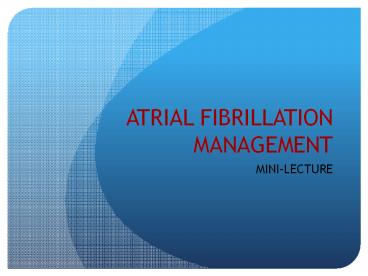ATRIAL FIBRILLATION MANAGEMENT - PowerPoint PPT Presentation
1 / 21
Title:
ATRIAL FIBRILLATION MANAGEMENT
Description:
ATRIAL FIBRILLATION MANAGEMENT MINI-LECTURE Answer: Although this patient is symptomatic they are hemodynamically stable and mentating well. There appears to be no ... – PowerPoint PPT presentation
Number of Views:224
Avg rating:3.0/5.0
Title: ATRIAL FIBRILLATION MANAGEMENT
1
ATRIAL FIBRILLATIONMANAGEMENT
- MINI-LECTURE
2
OBJECTIVES
- REVIEW INITIAL MANAGEMENT OF AFIB MEDICAL VS
CARDIOVERTING - MEDICAL MANAGEMENT RATE VS RHYTHM CONTROL
- ROLE OF ANTICOAGULATION
3
CASE VIGNETTE
- This is a 65 y/o M who presents to the ED with
dizziness, shortness of breath, and palpitations
which began approximately two hours ago when he
was playing catch with his grandson. No syncope
or chest pain. - On exam He is afebrile with a BP110/55,
HR110-162 bpm, and respiratory rate of 25.
AOx4 w/ NAD. Cardiac exam reveals tachycardia
with an irregularly irregular rhythm. - How would you approach the initial management of
this patient?
4
EKG
5
Demographics
- Common 2.2 million people in U.S.
- MalegtFemale
- Prevalence increases with age
- Leading cause of embolic strokes
- Associated with increased risk for heart failure
and all cause mortality
6
WORK-UP
- H and P
- CXR
- EKG
- Echo
- TFTs
- CMP
- Trop and EKG
7
MANAGEMENT
- The first step in management is to determine
whether the patient is stable or not - -Look for any hemodynamic instability such as
hypotension - -Is the patient responsive?
- -Are there any mental status changes?
- -are symptoms persistent and unbearable?
8
INITIAL MANAGEMENT DECISION
afib
Urgent Cardiovert
Unstable
Ss
Stable
Anticoagulate
Rate vs rhythm Control
9
RATE VS RHYTHM CONTROL
- Rate Control vs Rhythm Control
- no clear survival benefit in rate vs rhythm
control
10
RATE CONTROL
- Agents
- Beta Blocker Metoprolol and Propranolol
(ICUesmolol gtt) - Non-dihydropyridine CA blockers verapamil
Diltiazem (ICUdiltiazem gtt) - Digoxin
- Goal Rest 60-80 bpm and Activity 80-110
11
RATE CONTROL Which Agent to choose?
AFIB
SBP gt120
SBP 90-110
- SBP 100 to 120
DIGOXIN Load 0.5mg IV?6 hrs later 0.25mg IV?6
hrs later 0.25 mg IV Maintenance 0.125 mg daily
B-Blocker Initial Metoprolol 5mg IVP q5min
x3doses Prn metoprolol 5mg IV q6hr
prn Maintenance Metoprolol 25 mg po BID (max
100mg BID)
Ca2 Blockers Initial and prn Diltiazem 10mg IVP
q6hrs Maintenance Diltiazem 30mg PO q6hs
12
Rhythm Control
- AGENT
- III Amiodarone, Ibutilide, Dofetilide, Sotalol
- IC Flecainide, Propafenone
- IA Procainamide
13
ANTICOAGULATION
- Risk of stroke increases with valvular afib
- Risk of CVA4.5 per year in nonvalvular afib
- Risk of CVA in recurrent paroxysmal
afibpersistent afibpermanent afib - Agents ASA vs Coumadin vs Dabigatran vs
Rivaroxaban
14
ANTICOAGULATION Which Agent to Choose?
- CHADS2 SCORE
- CHF 1 point
- HTN 1 point
- AGE gt75 1 point
- DM 1 point
- Stroke or prior TIA 2 points
- Score
- 0ASA alone
- 1 either warfarin or ASA
- 2 or more warfarin
15
ASPRIRIN
- CHADS20 or 1
- 81 mg to 325mg PO daily
- Lower risk for bleeding than warfarin
- No need to check INRs etc
- Lower risk of major bleeds in patients who are a
fall risk
16
Coumadin
- For CHADS2 score 2 or greater and also 1
depending on patient and physician preference - Goal INR 2 to 3
- Must monitor INRs regularly
- Can be dangerous if fall risk or bleeding risk
high
17
ASA Clopidogrel
- If not a candidate for warfarin this can reduce
stroke risk greater than ASA alone - Risk for major bleeding increased
18
Dabigatran
- Direct Thrombin Inhibitor
- Alternative to warfarin for CHADS21 or greater
in those without valvular afib - RE-LY Trial showed superior to warfarin in
preventing ischemic and hemorrhagic CVAs with
reduced risk of life threatening bleeding but
higher risk of GI bleeds - No lab monitoring
- No reversal agent available for major bleeding
events
19
Rivaroxaban
- Oral factor Xa inhibitor
- Seems to be equivalent in efficacy to warfarin
for CVA prevention and no difference in major
bleeding events - Demonstrates a reduction in intracranial
hemorrhage - Note risk of thrombotic events increased for 28
days after stopping drug so may need to bridge
with another anticoagulant during this time.
20
SUMMARY
- AFIB very common arrhythmia and leading cause of
embolic CVAs - Initial Workup H and P, trop, EKG, TSH, Echo,
CXR, CMP - Management First must determine if stable vs
unstable (medically manage vs cardiovert
immediately) - For stable Afib rate vs rhythm control (equal
in efficacy). Start with rate control and if that
fails try rhythm. - Always remember to calculate CHADS2 score and
anticoagulate for CVA ppx.
21
References
- Uptodate.com Topics SVT, atrial fibrillation
management, afib overview - Sabatine, Marc S. Ed. Pocket Medicine The Mass
General Hospital Handbook of Internal Medicine
4th edition Lippincott Williams and Wilkins
Philadelphia, PA 2008. - MKSAP 16 Cardiology ACP 2012
- Maxine A. Papadakis, Stephen J. McPhee, Eds
CURRENT Diagnosis and Treatment McGraw Hill
Education 2012. - Dan L. Longo, Anthony S. Fauci, Dennis L. Kasper,
Stephen L. Hauser, J. Larry Jameson, Joseph
Loscalzo, Eds. Harrison's Principles of Internal
Medicine, Online. 18th ed. McGraw Hill 2012








![[PDF READ] Free Atrial Fibrillation Explained: Understanding PowerPoint PPT Presentation](https://s3.amazonaws.com/images.powershow.com/10084568.th0.jpg?_=20240724064)






















